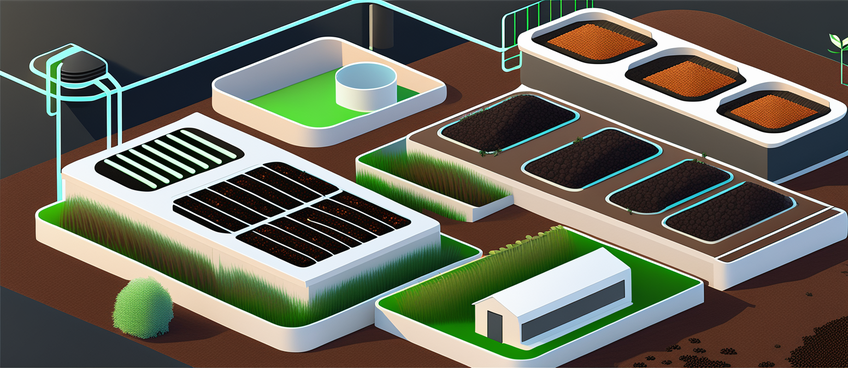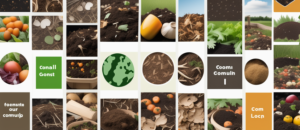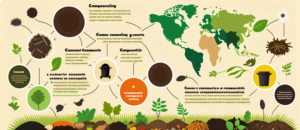Global Composting Trends: In today’s burgeoning eco-conscious world, composting the process of organic decomposition under controlled conditions remains an invaluable strategy in addressing environmental woes. This blog post ventures into a comprehensive discussion of composting trends from a cross-cultural perspective, underscoring its salience, significance, and, indeed, its future.
Composting Around the World: A Comparative Analysis
Composting in North America
North America stands at the forefront of composting, with initiatives mushrooming across both urban and suburban landscapes. In the United States, composting practices range from small-scale backyard composting to extensive municipal programs.
Various North American metropolises have adopted wide-reaching composting initiatives. San Franciscos mandatory composting ordinance, for example, has led to a dramatic reduction in landfill waste, highlighting the power of local action.
Composting in Europe
Composting in Europe European composting operates at a slightly different rhythm, spearheading innovations and making giant strides towards circular economies. Countries like the Netherlands and Belgium demonstrate a significant penchant for composting.
Europe’s flair for ingenuity can be seen in the advent of composting technologies, such as in-vessel composting a faster, climate-controlled alternative to traditional composting methods.
Composting in Asia
Composting in Asia, composting practices vary greatly, reflecting the region’s cultural diversity. While urban areas like Tokyo boast advanced composting facilities, rural regions often employ traditional methods like pit composting.
Asian composting techniques are invariably steeped in cultural wisdom, linking environmental conservation with age-old philosophies.
Benefits of Composting
Environmental Benefits
Composting boosts soil health, enriching it with vital nutrients and promoting biological diversity essential factors for maintaining ecosystem equilibrium.
By transforming organic waste into valuable compost, we can drastically reduce the quantum of landfill waste, mitigating the escalating landfill crisis.
Composting also aids in the reduction of greenhouse gas emissions. As composted organic matter decomposes, it releases carbon dioxide instead of methane, a potent greenhouse gas.
Economic Benefits
The economic implications of composting are two-fold. Not only does it curtail the costs associated with waste management, but it also spawns a lucrative market for organic fertilizers and soil amendments.
Also read: Comparative Study Efficiency of Different Composting Methods
Challenges in Global Composting
Despite its myriad benefits, composting does face hurdles. Lack of awareness, infrastructure deficits, and logistical challenges pose significant barriers, as do cultural and social perceptions about waste. Furthermore, regulatory landscapes often lack robust frameworks to support composting on a large scale.
Innovative Composting Methods and Technologies
Vermicomposting
Vermicomposting, which utilizes earthworms to expedite organic decay, presents a multitude of benefits. Besides producing nutrient-rich compost, it also contributes to pest management.
The Worm Café in Australia is a shining example of successful vermicomposting, demonstrating the potential of this composting method on a commercial scale.
Aerated Static Pile (ASP) Composting
ASP composting allows for quicker decomposition by aerating the compost pile, making it particularly suitable for large-scale applications.
The large-scale ASP system at the University of California, Berkeley, stands testament to the potential of this method, transforming the campus’s organic waste into fertile soil.
Bokashi Composting
Bokashi composting, a Japanese method that utilizes a select group of microorganisms to ferment organic waste, offers a practical solution for urban dwellers lacking outdoor space.
New York’s Reclaimed Organics has brought Bokashi composting into the mainstream, demonstrating its feasibility and versatility in an urban setting.
Cultural Factors Shaping Composting Practices
Historical Context
Traditional composting methods, ranging from the Indian ‘Khamba’ to the Japanese ‘Bokashi,’ continue to exert influence on modern composting practices.
Over time, these methods have evolved, shaped by the sociocultural contexts they operate within.
Religious and Spiritual Perspectives
Various religions propagate values of conservation, often influencing composting practices. For instance, many Buddhist monasteries in Japan compost as part of their ethos of living harmoniously with nature.
The act of composting has also found resonance in religious rituals and symbolism, such as the Native American tradition of returning the body to the earth.
Success Stories and Case Studies
Community-Based Composting Projects
In urban settings, initiatives like San Francisco’s urban composting program highlight the potential of community action.
Meanwhile, rural programs, like those in Ethiopia’s Tigray region, leverage composting for improving agricultural productivity and livelihoods.
Corporate and Industrial Composting
Within the food industry, corporations like Starbucks have successfully utilized composting to manage coffee grounds waste.
Large-scale composting is also prominent in sectors like manufacturing and landscaping, where vast quantities of organic waste can be repurposed beneficially.
Policy and Legislative Frameworks
Governmental Support for Composting
From national strategies like Frances Zero Waste policy to localized initiatives like Seattles mandatory composting, governments play a crucial role in fostering composting practices.
Municipal incentives, such as subsidies for compost bins, further encourage participation at the grassroots level.
International Collaborations and Agreements
On the global stage, the United Nations’ Sustainable Development Goals serve as a driving force behind composting promotion.
Cross-cultural partnerships, like the Indo-Dutch collaboration on waste management, also play a crucial role in advancing composting techniques.
The Future of Composting
Looking forward, composting will inevitably play a pivotal role in global sustainability strategies. Technological advancements, such as AI-controlled composting systems, promise a new era of precision and efficiency. Furthermore, integrating composting into broader circular economy models will help to capitalize on its full potential. Promoting composting as a global movement, however, will require concerted effort from all corners of society.
Conclusion of Global Composting Trends
From reducing landfill waste to fostering biodiversity, composting offers a panacea for a host of environmental challenges. As this cross-cultural analysis has shown, composting practices, rooted in diverse historical and cultural contexts, can bring about tangible benefits to our environment and economy. As global citizens, it falls upon us to embrace and promote composting, transforming waste into a resource and securing a sustainable future for all.
FAQs
Q1: What distinguishes composting from vermicomposting?
Ans: Microorganisms compost food scraps and yard waste into nutrient-rich soil conditioner. Vermicomposting uses worms, usually red wigglers, to speed up composting. Worms eat organic waste and produce nutrient-rich castings for plants.
Q2 Can all organic waste be composted?
Ans: Not all organic waste composts. Fruits, vegetables, coffee grounds, eggshells, yard waste, and non-glossy paper can be composted, but dairy, meats, oils, pet waste, and diseased plants cannot. These materials stink, attract pests, and spread disease.
Q3 How long is composting?
Ans: Composting time depends on the method, materials, and environment. Composting typically takes two months to two years. With good conditions and maintenance, compost can be ready in 23 months.
Q4 When is compost ready?
Ans: Mature compost is dark brown, crumbly, and earthy-smelling. Your compost is ready if the original organic materials are gone and the pile has shrunk. After turning, the compost pile should cool.
Q5 Can urbanites compost?
Ans: Yes. Vermicomposting and bokashi composting work well indoors. Many cities have community composting programs where residents can drop off organic waste.
Our Reader’s Queries
What is the trend in the compost market?
The Compost market is set to experience significant growth between 2023 and 2030. Currently, the market is growing steadily, and with the implementation of key strategies by industry leaders, it is expected to continue to rise in the coming years.
How big is the global compost market?
In just one year, the global compost market has seen a significant increase in size, growing from $6.82 billion in 2022 to $7.4 billion in 2023. This impressive growth can be attributed to a compound annual growth rate (CAGR) of 8.4%. It’s clear that the demand for compost is on the rise, and this trend is expected to continue in the coming years.
Is composting becoming more popular?
The population of American composters is on the rise. This is due to the increase in municipal collection programs, which are mandatory in some states like Vermont. Additionally, more people are becoming aware of the impact and value of their kitchen scraps, leading to a growing interest in composting. The process has also become much simpler, making it more accessible to everyone.
What is the future of composting?
According to this study, if we keep doing what we’re doing, the U.S. could boost its compost to waste ratio by 18% by 2030. This would cut carbon emissions by a whopping 30 million tons annually and save about 16 billion USD in municipal waste management expenses.



